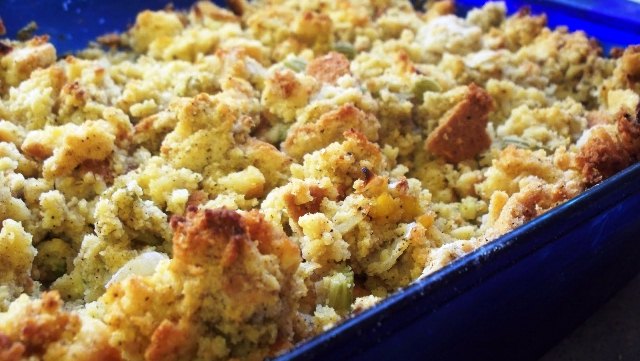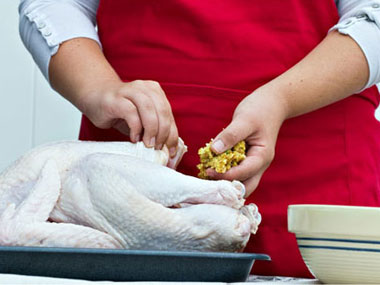From the archives…
Joining many great food debates such as; chili with beans or no beans, and tomato based or vinegar based BBQ sauce, the Thanksgiving rivalry between “stuffing” and “dressing” likely continues in your household. Depending on the regional composition of guests, they are likely to lean one way or the other. However, what is the real history behind this linguistic feud? Is there enough evidence to empirically name one terminology “correct?” Eh…probably not.
However I can provide you with the real facts, as they currently exist, so you can challenge your sister-in-law’s cousin’s neighbors friend at your upcoming family gathering.
Based on our research, this concept of “stuffing” not surprisingly appears in the very first cookbook that researchers have found. Sometime between the 2nd Century BC to the 1st Century AD, there existed a cook book authored by Apicius, a Roman culinary expert of his time. It is reported that in this cookbook, Apicius de re Coquinaria, he has recipes for stuffed chicken, hare, pig, and other animals using vegetables, herbs, nuts, and frequently, chopped liver, brains, and other organ meat. Naturally, “stuffing” gets it’s name from the act of stuffing something and is still used, in that specific expression today.
We also know “stuffing” in the middle ages was known as farce, from the Latin farcire (and French farcir) meaning to stuff and first appeared around 1390. Prior to the 16th Century, “stuffing/dressing” was known as farce in England. The term “stuffing” first appears in English print in 1538. However, In Victorian England around the 1880s, it appears the word “stuffing” was too crude and harsh for elite society. This is the first instance of referring to the contents derived from the act of stuffing a bird as “dressing.”
Therefore, one can deduce, that if you arrived to the Americas pre-1880, you called it “stuffing,” whereas post-1880 settlers, and specifically those of higher social status, called it “dressing.”
Fast forward to more modern times, Kraft introduced Stove Top Stuffing Mix to the masses in 1972, claiming it to be “instant stuffing.” However, it was not meant to be “stuffed” at all. It was, as the brand suggests, meant to be made on the stove. So does that mean stuffing you make on the stove is called dressing?
In a rational world, we would all agree that if you physically stuff your bird, then it’s called “stuffing;” and when you cook it on the side (be it stove top or baked), call it “dressing.” But in the bourbon, spiced-wine, turkey-coma, political conversation, football driven rage that is real life Thanksgiving, rational thought processes are likely force Uncle Stabby to start wielding around the electric carver!
So here’s what we know. Most Southerners call it “dressing” and most Northerners call it “stuffing.”
Regardless of what you call it, here are two recipes to satisfy the Southerners and Northerners in your life.
Southern Cornbread Dressing

First, make your cornbread. One cup cornmeal, 1/2 cup flour, 3/4 cup buttermilk, 2 eggs, 2 tablespoons vegetable oil. Combine in bowl, mix, pour into baking dish, bake at 350 for 20-25 minutes. Cool and cut into cubes.
Next, in a skillet over med-high heat, melt 6-8 tablespoons of butter, saute one large white onion (diced) with 2 cups of celery (diced) and half a diced green bell pepper. Pour over a bowl with your cubed corn bread inside. Add salt, pepper, sage, black pepper, garlic powder, onion powder, thyme, rosemary – all to taste. Add 5 beaten eggs. OPTIONAL: add shucked and rinsed oysters and/or sausage/chorizo.
Combine that mixture and pour into a greased pan and bake for 45 minutes at 350.
Northern (Yankee) Stuffing

Fairly easy and meant to be stuffed inside the turkey. Spread some white bread cubes on a pan and dry out overnight or just use package stuffing mix.
Melt a stick of butter on the stove. Add about one chopped onion and a few chopped celery stalks and cook until browned. Add to bread along with a couple teaspoons poultry seasoning, salt and pepper, and a raw egg to bind it all together. Mix in raisins, chopped apples, and walnuts.
Stuff into turkey and cook. However, please see below from the USDA who recommends you not cook stuffing inside the bird:
If you are cooking the stuffing inside of the bird, it is essential to use a food thermometer to determine the internal temperature of the bird and stuffing. Immediately place the stuffed, raw bird in a preheated oven set to 325 °F or higher. Even if the turkey itself has reached the safe minimum internal temperature of 165 °F (as measured in the innermost part of the thigh, the wing and the thickest part of the breast), the stuffing may not have reached a temperature high enough to destroy bacteria that may be present. Bacteria can survive in stuffing that has not reached 165 °F, which may cause foodborne illness. Use a food thermometer to be sure stuffed poultry or stuffing cooked separately in a casserole are safely cooked and have reached a safe minimum internal temperature of 165 °F. Even for experienced cooks, the improper heating and preparation of food means bacteria can survive.
Enjoy!

